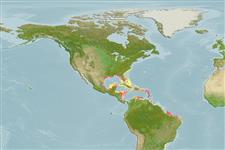Bathydrilus adriaticus (Hrabe, 1971)
| Native range | All suitable habitat | Point map | Year 2050 |

|
| This map was computer-generated and has not yet been reviewed. |
| Bathydrilus adriaticus AquaMaps Data sources: GBIF OBIS |
Google image |
No photo available for this species.
Classification / Names Κοινά ονόματα | Συνώνυμα | CoL | ITIS | WoRMS
Clitellata | Tubificida | Naididae
Environment: milieu / climate zone / εύρος βάθους / distribution range Οικολογία
Υφαλόφιλο(α); εύρος βάθους 0 - 32 m (Αναφ. 122024). Tropical
Distribution Χώρες | Περιοχές FAO | Οικοσυστήματα | Παρουσίες | Εισαγωγές
Circumtropical.
Length at first maturity / Μέγεθος / Weight / Age
Γεννητική Ωρίμανση: Lm ? range ? - ? cm Max length : 1.1 cm TL αρσενικό/απροσδιόριστο; (Αναφ. 122024)
Life cycle and mating behavior Γεννητική Ωρίμανση | Αναπαραγωγή | Γεννοβολία | Eggs | Γονιμότητα | Larvae
Main reference
Αναφορές | Συντονιστής | Συνεργάτες
Diaz, R.J. and C. Erseus 1994 Habitat preferences and species associations of shallow-water marine Tubificidae (Oligochaeta) from the barrier reef ecosystems off Belize, Central America. Hydrobiologia 278:93-105. (Αναφ. 86698)
IUCN Red List Status
(Αναφ. 130435: Version 2025-1)
CITES status (Αναφ. 108899)
CMS (Αναφ. 116361)
Threat to humans
Human uses
| FishSource |
Εργαλεία
Περισσότερες πληροφορίες
Σύσταση δίαιτας
Κατανάλωση τροφής
Θηρευτές
Διαδικτυακές πηγές
BHL | BOLD Systems | CISTI | DiscoverLife | FAO(Publication : search) | Fishipedia | GenBank (genome, nucleotide) | GloBI | Gomexsi | Google Books | Google Scholar | Google | PubMed | Δέντρο Ζωής | Wikipedia (Go, αναζήτηση) | Zoological Record


